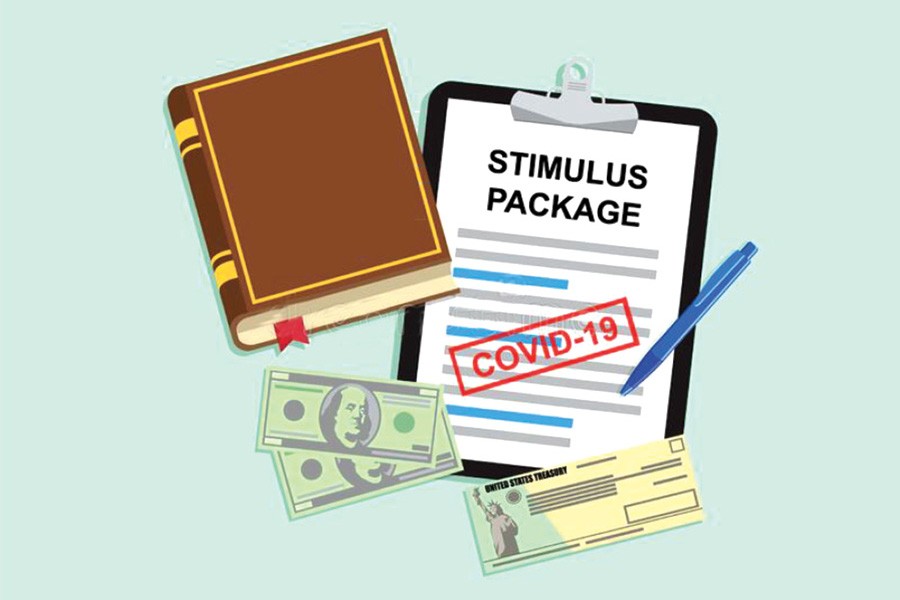Practically speaking, there are no absolute free market economies anywhere in the world. The United States' economy may be the closest to resembling a free market. However, the federal and state governments still have a lion's say in steering the US economy. Henceforth, everywhere else in the world Bangladesh being no exception, governments exercise a great deal of influence on their country's economy. And at present when almost all economies have come to an unprecedented standstill, all governments have taken steps to minimise the economic impact brought by this pandemic. There are a lot of similarities in these steps but it will still be interesting to know what has been done and how these central actions differ between developed and developing countries.
In order to gain a perspective of developing countries, let us analyse the stimulus package for Bangladesh. Bangladesh Bank has also come to the liquidity aid of the country by announcing moratorium on payments until June 30 of this year. Exporting industries of Bangladesh are to receive US$ 595 million at two per cent interest. US$ 8 billion is also to be implemented in different phases ranging from immediate to long term. This will consist of boosting money supply, increasing public expenditure and widening social safety net coverage. A breakdown of this is Tk 300 billion given to banks to support working capital requirements of industries. Half of the nine percent interest on these loans are to be borne by government. The central bank's Revolving Refinance Scheme of Tk 150 billion enables banks to borrow 50 per cent of BB's disbursements at four per cent. For SMEs' working capital this stimulus package carries Tk 200 billion. Interest rate is the same for larger industries. However, the government will foot five per cent out of the nine per cent cost of funds. The Revolving Refinance Scheme worth Tk 100 billion carries the same terms. There is further support for exporters as the government has arranged a back to back LC and a boost of the export development fund by US$ 1.5 billion. The interest rate will be a meagre two per cent. The final segment of this package consists of a Tk 50 billion pre-shipment refinance scheme from BB's source charged at three per cent to banks and six per cent by banks to the public. Besides these, Bangladesh received $100 million aid from the World Bank and a pledge of £22mn from the UK government. Bangladesh can also access the SAARC development fund of up to $5 m.
Now government stimulus compositions are fairly similar in developed countries, however the magnitude differs greatly. Then again it still scales up to a similar percentage of the GDP. For instance, America has launched the biggest stimulus package in history at a whopping two trillion plus USD with an exponential push for unemployment benefits, a half trillion dollar lending programme, a survival stimulus to the ailing airlines industry, sizeable stimulus for hospitals, protection for contractors and 'gig' workers who are not registered employees for any organisation, housing protection by preventing evictions of renters and foreclosures of mortgages by providing cost free loans and making it illegal to evict tenants for inability to pay rent. An amount of $450 million are directed towards food assistance programmes. Furthermore, the bill includes funds for evacuation of Americans and support for the Peace Corps, diplomatic programmes and refugees.
The European Union has discarded its policies pertaining to public deficits through a 750 billion Euro stimulus package out of the European Central Bank. Italy, one of the hardest hit countries, and Spain following suit, this breaking of policy was necessary. The ECB's Pandemic Emergency Purchase Programme (PEPP) which stands at 7.3 per cent of the Eurozone's GDP, aims to fulfil the liquidity needs of all sectors of EU economies. It consists of a temporary public and private sector security purchase programme injecting 120 billion euros. This stimulus can benefit households, companies, governments and banks.
The Italian government's individual stimulus packages are a combined 750 billion euros which is almost 50 per cent of the country's GDP. The aggregate of individual liquidity national measures of all EU countries stands at 26,355 billion euros. This consists of tax delays and public guarantees among others. The aggregate for national expenditure and fiscal measures out to 4,332 billion.
Conclusively, we can observe that the Covid stimulus does not vary widely in terms of the policies governments deploy. Developed countries just pump much larger funds into their economies in comparison. However, developing countries are eligible to receive aid from international bodies and developed counterparts. The aims of government actions with regard to economic action is actually very uniformed. It is to ensure that key industries survive, SMEs pull through, and workers keep their jobs so that once the sun sets on this pandemic the countries will have a backbone to rebuild their economies to their pre-Covid glory. The success and sustainability of these packages will, however, depend on when the world is finally freed from coronavirus.
The writer is a third-year student of BBA programme at the Institute of Business Administration (IBA), University of Dhaka. He can be reached at
[email protected]


